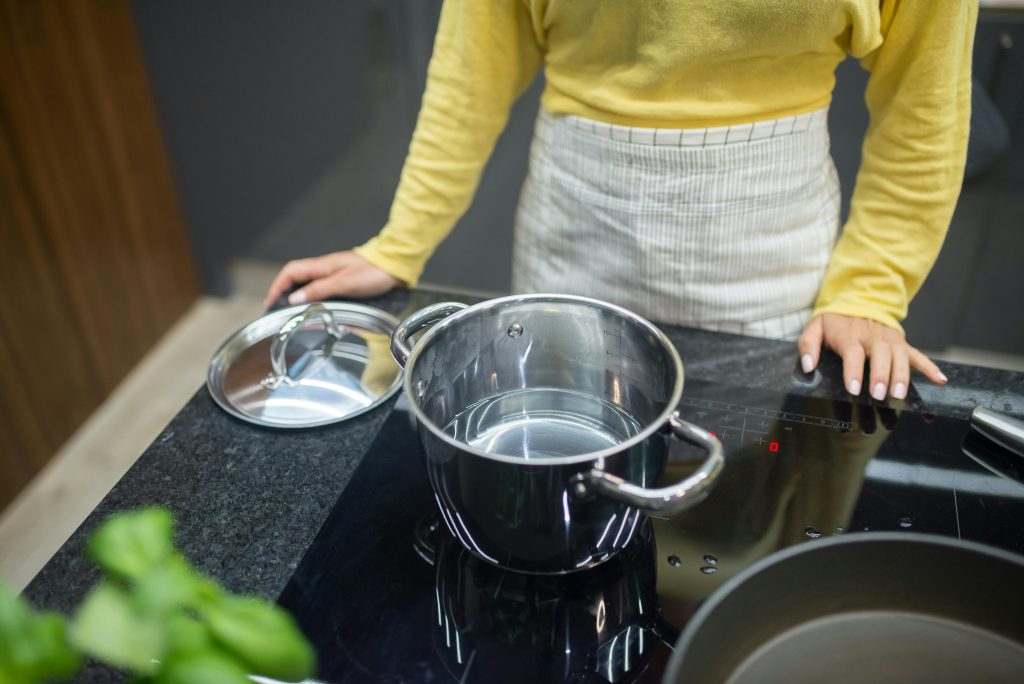Table of Contents
In the realm of kitchen appliances, induction cooking has emerged as a revolutionary technology, offering efficiency, precision, and safety. Unlike traditional gas or electric cooktops, induction cooktops use electromagnetic fields to heat pots and pans directly. This method of cooking is not only faster but also more energy-efficient and environmentally friendly. This article explores the principles behind induction cooking, its benefits, and its growing popularity in modern kitchens.

The Science Behind Induction Cooking
Induction cooking is based on the principle of electromagnetic induction. When an induction cooktop is turned on, an electric current passes through a coil beneath the cooktop’s surface, creating an electromagnetic field. This field induces an electric current in the ferromagnetic cookware placed on the cooktop, generating heat directly within the cookware. This direct transfer of energy results in quicker heating and greater control over cooking temperatures.
One of the key features of induction cooking is that the cooktop itself remains cool to the touch. Only the cookware and its contents are heated, which significantly reduces the risk of burns and makes the cooktop safer to use, especially in households with children. Additionally, the cool surface prevents spills from burning onto the cooktop, making cleaning much easier.

Advantages of Induction Cooking
Efficiency and Speed
Induction cooktops are known for their remarkable efficiency. They transfer energy directly to the cookware, minimizing heat loss and reducing cooking times. Water boils in a fraction of the time compared to gas or electric stoves, and food cooks more evenly. This efficiency not only saves time but also reduces energy consumption, making induction cooking an eco-friendly choice.
Precision and Control
Induction cooktops offer precise temperature control, allowing for immediate adjustments. This level of control is particularly beneficial for delicate cooking tasks, such as melting chocolate or simmering sauces, where precise temperature management is crucial. Chefs and home cooks alike appreciate the ability to maintain consistent temperatures, resulting in better cooking outcomes.
Safety
Safety is a significant advantage of induction cooking. Since the cooktop itself does not get hot, the risk of accidental burns is minimized. Additionally, induction cooktops often come with safety features such as automatic shut-off, child locks, and sensors that detect whether cookware is present. These features make induction cooktops an excellent choice for families with young children or elderly members.
Cleanliness
Cleaning an induction cooktop is straightforward due to its smooth, flat surface. Since the cooktop remains relatively cool, spills do not burn onto the surface, making it easy to wipe clean with a damp cloth. This convenience adds to the overall appeal of induction cooking, especially for those who value a tidy kitchen.

The Growing Popularity of Induction Cooking
Induction cooking has gained popularity in recent years, driven by its numerous benefits and the increasing awareness of energy conservation. As consumers become more environmentally conscious, the demand for energy-efficient appliances has risen. Induction cooktops, with their superior energy efficiency, align perfectly with this trend.
Moreover, the sleek and modern design of induction cooktops appeals to contemporary kitchen aesthetics. Homeowners and interior designers favor induction cooktops for their minimalist look and seamless integration into kitchen countertops. The absence of open flames or exposed heating elements also contributes to a cleaner and more sophisticated kitchen design.
Considerations When Choosing Induction Cooktops
While induction cooking offers many advantages, there are a few considerations to keep in mind when choosing an induction cooktop. First, induction cooktops require compatible cookware made of ferromagnetic materials, such as cast iron or stainless steel. Aluminum, copper, and glass cookware will not work on induction cooktops unless they have a magnetic layer on the bottom.
Additionally, the initial cost of induction cooktops can be higher than that of traditional gas or electric stoves. However, the long-term energy savings and the benefits of faster cooking times and improved safety often justify the investment.
Conclusion
Induction cooking represents a significant advancement in kitchen technology, offering a combination of speed, efficiency, precision, and safety that traditional cooking methods cannot match. As more consumers recognize the benefits of induction cooktops, their popularity continues to grow. Whether you are a professional chef or a home cook, induction cooking can elevate your culinary experience, making it a worthwhile addition to any modern kitchen. With its promising blend of innovation and practicality, induction cooking is set to shape the future of culinary arts, providing a smart, sustainable, and stylish solution for cooking enthusiasts around the world.


